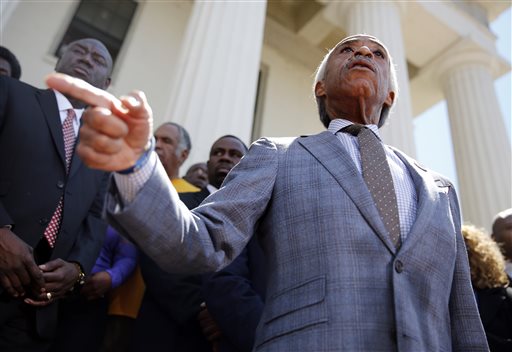National
Back in Spotlight, Sharpton Seizes the Moment


Civil rights leader Rev. Al Sharpton speaks during a news conference outside the Old Courthouse Tuesday, Aug. 12, 2014, in St. Louis. Racial tensions have run high in Ferguson, Mo., where crowds have looted and burned stores, vandalized vehicles and taunted police after following the shooting death of Michael Brown, 18, an unarmed black man by police. (AP Photo/Jeff Roberson)
ADAM GELLER, AP National Writer
Stepping to the pulpit at Greater Grace Church — minutes from where a suburban St. Louis police officer shot and killed an unarmed black 18-year-old — civil rights leader Rev. Al Sharpton wielded the fiery words that have marked his long, often notorious career.
“These parents are not going to cry alone,” he preached to the crowd that packed the pews last Sunday in Ferguson, Missouri. “We have had enough!” But when Sharpton sat down days later with New York’s mayor to discuss the response to a man’s death in a police officer’s chokehold, he recalibrated his rhetoric. “We don’t have to agree on everything, but we don’t have to be disagreeable,” Sharpton said, facing the city’s police commissioner.
Plenty has been said in recent years about Sharpton’s “reinvention,” as he shed nearly 170 pounds (77 kilograms), traded warmup outfits for tailored suits, took to the camera for a daily cable television show, and built relationships with the White House and New York’s city hall. But to allies and critics who have watched him parachute into racially charged crises for more than three decades, recent weeks are just testament to Sharpton’s unflagging ability to seize the moment, regardless of setbacks and no matter how the opening presents itself.
“He always seems to be in the right places and seems to be able to absorb and overcome some devastating blows,” said the Rev. Herbert Daughtry, 84, who has known Sharpton since he was a boy preacher at Brooklyn’s Washington Temple and has marched alongside him time and again. “I don’t see that he’s changed. The core of Rev. Sharpton is the same … the root is the same, the substance is the same.”
Sharpton returned to Ferguson on Monday and spoke at the funeral for Michael Brown, cementing his place at the intersection of advocacy and controversy.
In his eulogy, he told an audience of thousands that something is wrong when money is provided to give military equipment to police, but there isn’t enough money for public schools. He called Brown’s death a seminal moment in the country and took the black community to task, saying it should be as upset about black-on-black crime as it is about police violence: “We have to be outraged by our disrespect for each other.”
Sharpton first commanded national attention in 1987 as the medallion-wearing, 305-pound (138-kilogram) spitfire demanding justice for an upstate New York teen, Tawana Brawley, in the uproar surrounding what turned out to be a made-up rape.
He was widely derided for his incendiary rhetoric, but his doggedness earned credibility with some blacks as the voice of the street, says David Bositis, an analyst specializing in African-American politics who counseled Sharpton before his 2004 run for president. The activist’s change in tone since then is no accident, he said.
Now 59, Sharpton was raised by his mother after his father left home when he was in grade school. By age 4, he was delivering “eloquently precocious” sermons in Brooklyn churches, Daughtry said. When he was just 15, local activists pointed him out to civil rights leader Jesse Jackson, who named Sharpton youth director of Operation Breadbasket, the New York branch of an effort to improve economics in black neighborhoods.
Still in his teens, Sharpton went on the road with soul idol James Brown, whose role as surrogate father inspired his prominent perm, since tamed. In 1984, Sharpton led protests demanding the prosecution of Bernhard Goetz, a white man who opened fire on four black teens in the New York subway.
In crisis after crisis, Sharpton begged controversy. In 1995, he lambasted the Jewish owner of a store in Harlem, labeling him a “white interloper.” Soon after, a protester set fire to the store, killing eight people.
At the 1991 funeral for a black boy struck and killed by the car of an Orthodox rabbi in Brooklyn’s Crown Heights section, Sharpton railed against the neighborhood’s “diamond merchants.”
“There was an anti-Semitic tide running through that neighborhood and he fueled it,” said Wayne Barrett, a former investigative reporter for New York’s Village Voice who covered the aftermath.
In recent years, Sharpton has acknowledged “mistakes.” Critics say he can’t undo the damage. But many African-Americans, agreeing with the core of Sharpton’s insistent message, have looked past the errors, said Mary Frances Berry, a scholar of black American history and politics at the University of Pennsylvania.
“What he did was to keep on moving,” she said.
The setbacks went beyond rhetorical missteps. In the 1990s, Sharpton was acquitted of tax fraud and stealing from one of his charities. He later pleaded guilty to failing to file a state tax return. In 2008, he filed long overdue returns that showed he owned nearly $1.5 million in taxes, and negotiated a repayment plan with the government. This spring, he faced tough questions after reports he served as an FBI informant in the 1980s.
Undeterred, Sharpton has moved to fill the void left by Jackson, who has been far less visible in recent years.
“Who on the national scene was going to play that role?” Berry said. “If Al Sharpton didn’t exist we’d have to invent him, where he’s invented himself several times.”
___
Adam Geller, a New York-based national writer, can be reached at features@ap.org. Follow him on Twitter at https://twitter.com/adgeller
Copyright 2014 The Associated Press. All rights reserved. This material may not be published, broadcast, rewritten or redistributed.







































